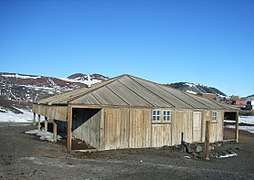Hut-Point-Halbinsel
| Hut-Point-Halbinsel | ||
| Geographische Lage | ||
| Koordinaten | 77° 46′ S, 166° 51′ O | |
| Lage | Ross-Insel (Ross-Archipel) | |
| Gewässer 1 | Erebus Bay (Rossmeer) | |
| Gewässer 2 | Ross-Schelfeis | |
| Länge | 24 km | |
| Breite | 4,8 km | |
 Ross-Insel mit Hut-Point-Halbinsel (links unten) | ||
Die Hut-Point-Halbinsel (englisch Hut Point Peninsula) ist der südwestliche Ausläufer der antarktischen Ross-Insel. Die südöstliche Flanke der etwa 4,8 Kilometer breiten und 24 Kilometer langen Halbinsel ist dem Ross-Schelfeis zugewandt, im Westen grenzt sie an die Erebus Bay. Das südliche Ende der Halbinsel, zugleich die Südspitze der gesamten Insel, ist Kap Armitage.
Als Teil einer Vulkaninsel besteht die Hut-Point-Halbinsel aus einer Reihe vulkanischer Schlackenkegel, deren höchste Erhebung Castle Rock ist mit einer Höhe von 413 m. Gesteinsdatierungen ergaben ein pleistozänes Alter von 1,2 bis 0,3 Mio. Jahren.[1]
Die Discovery-Expedition (1901–1904) unter Robert Falcon Scott baute ihre Hütte (englisch hut) am Hut Point, einer Landspitze, die etwa 1,6 Kilometer nordwestlich von Kap Armitage am südlichen Ende der Halbinsel liegt, heute unweit der McMurdo-Station. Mitglieder von Scotts Terra-Nova-Expedition (1910–1913) nutzten die Hütte oft auf ihren Reisen, obwohl sie ihr Basislager am Kap Evans hatten. Sie prägten auch den Namen „Hut-Point-Halbinsel“.
Die US-amerikanische McMurdo-Station und die neuseeländische Scott Base sind Forschungsstationen nahe der Spitze der Hut-Point-Halbinsel.
Weblinks
- Hut Point Peninsula im Global Volcanism Program der Smithsonian Institution (englisch).
- Hut Point Peninsula im Geographic Names Information System des United States Geological Survey.
Einzelnachweise
- ↑ Lisa Tauxe et al.: Paleomagnetism and 40Ar/39Ar ages from volcanics extruded during the Matuyama and Brunhes Chrons near McMurdo Sound, Antarctica. In: Geochemistry, Geophysics, Geosystems. Band 5, Nr. 6, Juni 2004, ISSN 1525-2027, doi:10.1029/2003GC000656 (englisch).
Auf dieser Seite verwendete Medien
Autor/Urheber: Alexrk2, Lizenz: CC BY-SA 3.0
Physische Positionskarte Antarktis, Mittabstandstreue Azimutalprojektion
Autor/Urheber: User:RedSolution, Lizenz: CC BY-SA 2.5
Karte der Ross-Insel, Antarktis
كوخ ديسكفري الخاص بسكوت في هت بوينت، استُخدم مأوى ومستودعا للمخازن.
Wonders in the Antarctic Sea and Sky - NASA aircraft and scientists have returned to the United States after a short ice-surveying mission to Antarctica. Despite having only a week of flying time, the team returned with crucial scientific data and a trove of spectacular aerial photographs.
The flights over Antarctica were part of Operation IceBridge, a multi-year mission to monitor conditions in Antarctica and the Arctic until a new ice-monitoring satellite, ICESat-2, launches in 2016. ICESat-1 was decommissioned in 2009, and IceBridge aircraft have been flying ever since.
Previous Antarctic IceBridge flights took off from Punta Arenas, Chile, but this time NASA’s P-3 took off from the sea ice runway at McMurdo Station, a first for the team. Operated by the National Science Foundation, the station is located on Antarctica’s Ross Island. Flying from McMurdo meant the IceBridge team was able to survey some areas that were unreachable from Chile.
In 43 hours across five science flights in late November, the P-3 collected more than 20,000 kilometers (12,000 miles) worth of science data. Instruments gathered information about the thickness of the ice over subglacial lakes, mountains, coasts, and frozen seas.
Laser altimeter and radar data are the primary products of the mission, but IceBridge project scientist Michael Studinger almost always has his digital camera ready as well. On November 24, 2013, he took the top photograph of a multi-layered lenticular cloud hovering near Mount Discovery, a volcano about 70 kilometers (44 miles) southwest of McMurdo. The Operational Land Imager (OLI) on Landsat 8 captured a wider satellite view (second image) of McMurdo and New Zealand’s nearby Scott Base on November 30, 2013.
Lenticular clouds are a type of wave cloud. They usually form when a layer of air near the surface encounters a topographic barrier, gets pushed upward, and flows over it as a series of atmospheric gravity waves. Lenticular clouds form at the crest of the waves, where the air is coolest and water vapor is most likely to condense into cloud droplets. The bulging sea ice in the foreground is a pressure ridge, which formed when separate ice floes collided and piled up on each other.
See more photography from the 2013 Antarctic IceBridge campaign here and here. Read a blog about the campaign on our Notes from the Field page.
Instrument:
Landsat 8 - OLI





